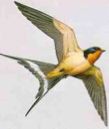 Blackberries - Love 'em and eat'em!
Blackberries - Love 'em and eat'em! Blackberries - Love 'em and eat'em!
Blackberries - Love 'em and eat'em!
For many people, few summertime traditions are as cherished as the annual harvest of scrumptiously good Himalayan blackberries for jams and pies. Introduced from India by Luther Burbank in 1885, these prolific berry producers quickly spread to moist lowland areas throughout California because they are loved by birds as well as people. Blackberry seeds sprout as soon as they have passed through a bird's gut, and flying birds readily transport them to new sites. Once established, these plants utterly dominate their new homes through extensive vegetative shooting. The flowers don't even need to be pollinated before producing fruit, saving the plant precious energy. The mass of a fully developed thicket-also known as a bramble-can exceed twelve tons per acre and form a towering wall of impenetrable thorns. Laden with succulent fruit, the blackberry gives fresh meaning to the term "sorely tempting." Who hasn't suffered countless pricks picking their fill? While the Himalayan Blackberry is not native to the Laguna, it does provide nectar, food and habitat for song sparrows, marsh wrens and many other birds.
Let's Ponder: Which plants are displaced by Himalayan Blackberry? Which plants might be growing in their place?

Those master aerialists-the six species of swallows common in California-launch a spectacular if little recognized migration each summer. Completely dependent on small flying insects for food, swallows seem to realize before other animals do, that summer's bounty is coming to an end. For the past month, they have been swooping up into massive flocks around fields in moist valley bottoms. These congregations can reach impressive proportions. Scant published records cite 100,000 tree and cliff swallows at the south end of the Salton Sea, a number likely exceeded by gatherings in the Central Valley. Once massed, these huge flocks quickly work their way over the southern horizon with different species wintering from Mexico to Tierra del Fuego. But an annual gathering in Oregon's Willamette Valley that exceeds 500,000 barn swallows apparently dwarfs our state's record. It would be exciting to better document California's swallow migration and see how high our own numbers soar. As of September 20, there were still many (300 counted) tree, violet green and barn swallows feeding on the wing at the Sebastopol Preserve. Notice that the last swallows to leave the Laguna will be barn swallows.
Let's Ponder: While the swallows are leaving, which birds are returning or passing through the Laguna?
 One of our Laguna "anchor" plants: "Leaves of
three, let them be, Berries of white, poisonous sight."
One of our Laguna "anchor" plants: "Leaves of
three, let them be, Berries of white, poisonous sight."
Poison oak is the bane of countless outdoor enthusiasts in the West. To protect itself, the plant secretes phenolic compounds known as resorcinols and catechols. If touched or inhaled as smoke, these chemicals can land some people in hospital. Along the coast, local poison oak strains will raise terrible skin rashes on those who touch the oily leaves. Milder forms grow in the Sierra Nevada. The familiar three-leaved shape of poison oak rouses only horror in the viewer's eye, although the leaves turn a gorgeous deep red color before they are shed. Like an autumn display in the understory, these fiery colors add a lively touch to an otherwise dry, dusty landscape. Once the leaves drop, the plant's small whitish fruit becomes much more noticeable. Thrushes, wrentits, towhees, and other small birds will feed on the berries all winter. Though this plant gets little appreciation from humans, it is an important component of the Laguna ecosystem where it grows.
 From The Coast Miwok Indians:
From The Coast Miwok Indians:
"Old men and
some women smoked wild tobacco, kayaw, in a straight
elderberry pipe. Kayaw was traded from the
Southern Pomo people. A narcotic plant calley
monoy or tulwach was brought from the
Santa Rosa area and was sometimes used by dancers to produce
visions." The plant the Coast Miwok calls "monoy" is the
datura plant we see sprouting, blooming and forming large seed pods
in the fields and in our yards at this time of the year.
Datura is extremely poisonous.